复合不定代词
- 格式:ppt
- 大小:458.50 KB
- 文档页数:35
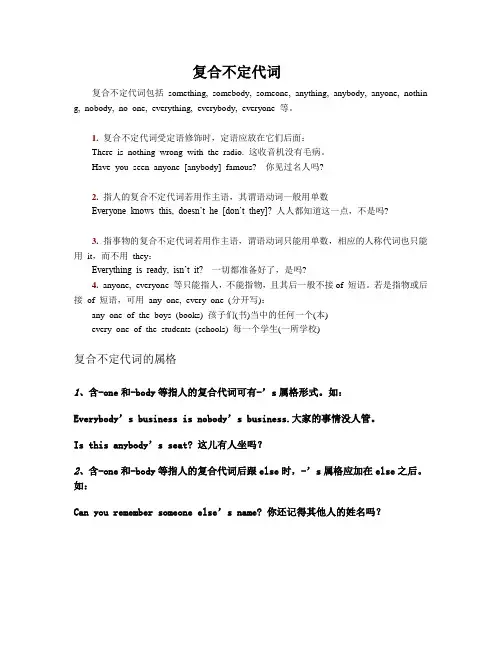
复合不定代词复合不定代词包括something, somebody, someone, anything, anybody, anyone, nothin g, nobody, no one, everything, everybody, everyone 等。
1.复合不定代词受定语修饰时,定语应放在它们后面:There is nothing wrong with the radio. 这收音机没有毛病。
Have you seen anyone [anybody] famous? 你见过名人吗?2.指人的复合不定代词若用作主语,其谓语动词一般用单数Everyone knows this, doesn’t he [don’t they]? 人人都知道这一点,不是吗?3.指事物的复合不定代词若用作主语,谓语动词只能用单数,相应的人称代词也只能用it,而不用they:Everything is ready, isn’t it? 一切都准备好了,是吗?4.anyone, everyone 等只能指人,不能指物,且其后一般不接of 短语。
若是指物或后接of 短语,可用any one, every one (分开写):any one of the boys (books) 孩子们(书)当中的任何一个(本)every one of the students (schools) 每一个学生(一所学校)复合不定代词的属格1、含-one和-body等指人的复合代词可有-’s属格形式。
如:Everybody’s business is nobody’s b usiness.大家的事情没人管。
Is this anybody’s seat? 这儿有人坐吗?2、含-one和-body等指人的复合代词后跟else时,-’s属格应加在else之后。
如:Can you remember someone else’s name? 你还记得其他人的姓名吗?单词部分字母发音字母组合发音all [ɔ:] tall small ball fall call ar [ɑ:] car arm farm garden ck [k] black back socksgh 不发音right high eight light le [l] apple purple noodles默写下列单词。
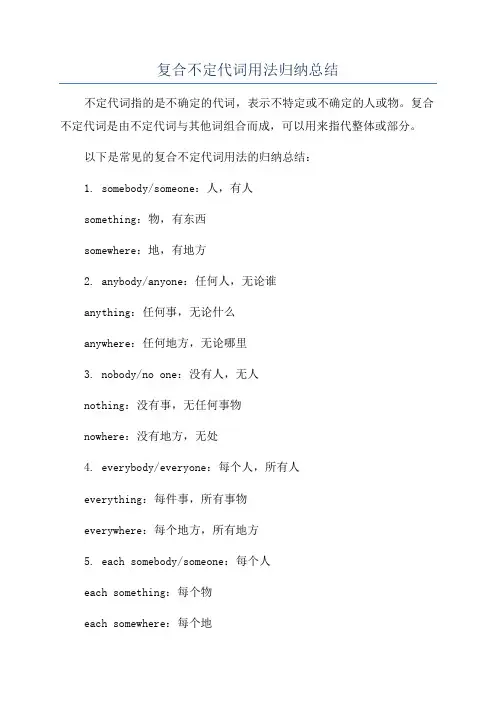
复合不定代词用法归纳总结不定代词指的是不确定的代词,表示不特定或不确定的人或物。
复合不定代词是由不定代词与其他词组合而成,可以用来指代整体或部分。
以下是常见的复合不定代词用法的归纳总结:1. somebody/someone:人,有人something:物,有东西somewhere:地,有地方2. anybody/anyone:任何人,无论谁anything:任何事,无论什么anywhere:任何地方,无论哪里3. nobody/no one:没有人,无人nothing:没有事,无任何事物nowhere:没有地方,无处4. everybody/everyone:每个人,所有人everything:每件事,所有事物everywhere:每个地方,所有地方5. each somebody/someone:每个人each something:每个物each somewhere:每个地6. some somebody/someone:一些人some something:一些物some somewhere:一些地7. no somebody/someone:没有人no something:没有物no somewhere:没有地8. both somebody/someone:两个人both something:两个物both somewhere:两个地9. either somebody/someone:任一个人either something:任一个物either somewhere:任一个地10. neither somebody/someone:两个都不是人neither something:两个都不是物neither somewhere:两个都不是地11. all somebody/someone:所有人all something:所有物all somewhere:所有地这些复合不定代词可以在句子中作主语、宾语、或者介词的宾语等,具体用法要根据上下文语境来确定。
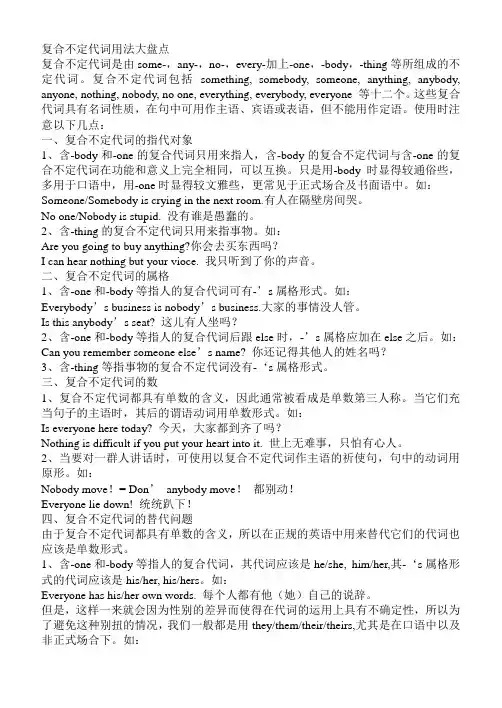
复合不定代词用法大盘点复合不定代词是由some-,any-,no-,every-加上-one,-body,-thing等所组成的不定代词。
复合不定代词包括something, somebody, someone, anything, anybody, anyone, nothing, nobody, no one, everything, everybody, everyone 等十二个。
这些复合代词具有名词性质,在句中可用作主语、宾语或表语,但不能用作定语。
使用时注意以下几点:一、复合不定代词的指代对象1、含-body和-one的复合代词只用来指人,含-body的复合不定代词与含-one的复合不定代词在功能和意义上完全相同,可以互换。
只是用-body时显得较通俗些,多用于口语中,用-one时显得较文雅些,更常见于正式场合及书面语中。
如:Someone/Somebody is crying in the next room.有人在隔壁房间哭。
No one/Nobody is stupid. 没有谁是愚蠢的。
2、含-thing的复合不定代词只用来指事物。
如:Are you going to buy anything?你会去买东西吗?I can hear nothing but your vioce. 我只听到了你的声音。
二、复合不定代词的属格1、含-one和-body等指人的复合代词可有-’s属格形式。
如:Everybody’s business is nobody’s business.大家的事情没人管。
Is this anybody’s seat? 这儿有人坐吗?2、含-one和-body等指人的复合代词后跟else时,-’s属格应加在else之后。
如:Can you remember someone else’s name? 你还记得其他人的姓名吗?3、含-thing等指事物的复合不定代词没有-‘s属格形式。
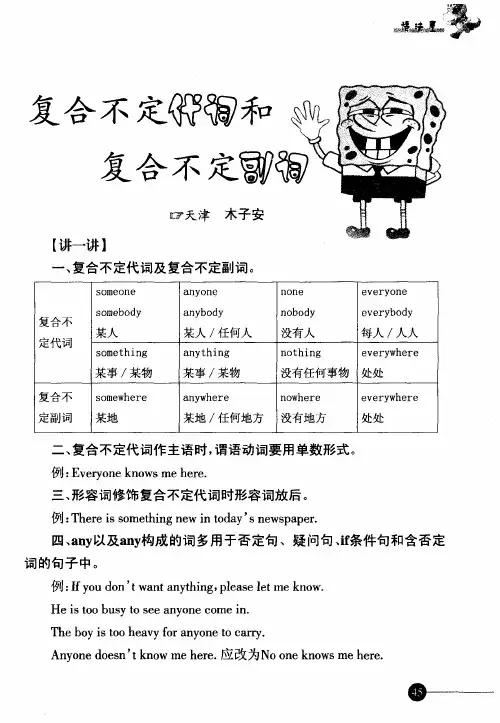
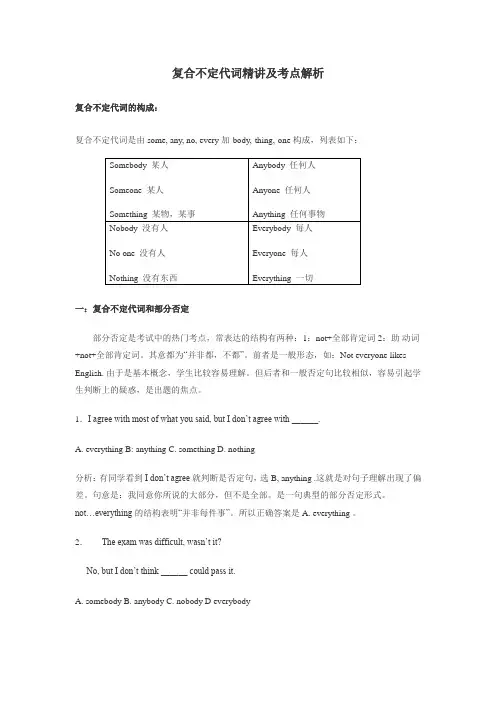
复合不定代词精讲及考点解析复合不定代词的构成:复合不定代词是由some, any, no, every加-body,-thing,-one构成,列表如下:一:复合不定代词和部分否定部分否定是考试中的热门考点,常表达的结构有两种:1:not+全部肯定词 2:助动词+not+全部肯定词。
其意都为“并非都,不都”。
前者是一般形态,如:Not everyone likes English. 由于是基本概念,学生比较容易理解。
但后者和一般否定句比较相似,容易引起学生判断上的疑惑,是出题的焦点。
1.I agree with most of what you said, but I don’t agree with ______.A. everything B: anything C. something D. nothing分析:有同学看到I don’t agree就判断是否定句,选B, anything .这就是对句子理解出现了偏差。
句意是:我同意你所说的大部分,但不是全部。
是一句典型的部分否定形式。
not…everything的结构表明“并非每件事”。
所以正确答案是A. everything 。
2. ----The exam was difficult, wasn’t it?----No, but I don’t think ______ could pass it.A. somebodyB. anybodyC. nobody D everybody分析:同上题一样,不能将I don’t think简单得看成否定句而选B. anybody。
“not…everybody”构成部分否定,既“并非所有的人都能通过”。
所以应该选D. everybody。
二:复合不定代词的定语位置复合不定代词被定语修饰的时候,定语必须放在不定代词后面。
特别是当修饰的定语比较复杂的情况下要认真分析,弄清词序间的修饰关系。
1. There is _____________ with your car.A. nothing seriously wrongB. seriously wrong nothingC. nothing wrong seriouslyD. wrong seriously nothing分析:首先,seriously副词修饰wrong 形容词,seriously wrong表示“严重损坏”,seriously wrong 修饰nothing, 放在nothing 后面,意思是“严重损坏的地方”,nothing seriously wrong , 所以答案是A。

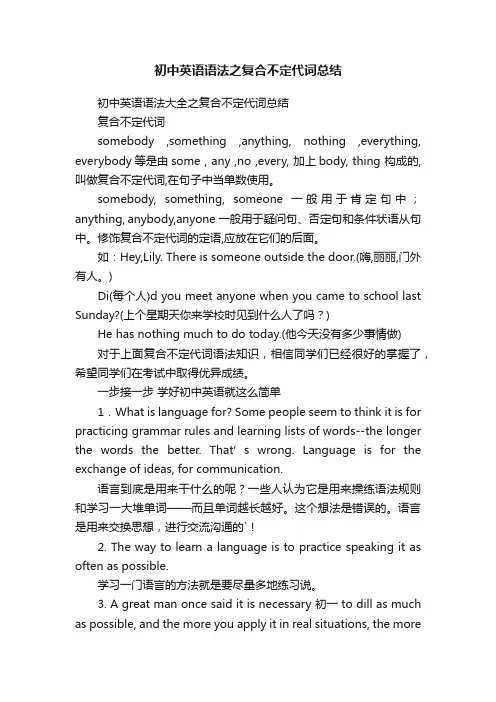
初中英语语法之复合不定代词总结初中英语语法大全之复合不定代词总结复合不定代词somebody ,something ,anything, nothing ,everything, everybody等是由some , any ,no ,every, 加上body, thing 构成的,叫做复合不定代词,在句子中当单数使用。
somebody, something, someone 一般用于肯定句中;anything, anybody,anyone一般用于疑问句、否定句和条件状语从句中。
修饰复合不定代词的定语,应放在它们的后面。
如:Hey,Lily. There is someone outside the door.(嗨,丽丽,门外有人。
)Di(每个人)d you meet anyone when you came to school last Sunday?(上个星期天你来学校时见到什么人了吗?)He has nothing much to do today.(他今天没有多少事情做)对于上面复合不定代词语法知识,相信同学们已经很好的掌握了,希望同学们在考试中取得优异成绩。
一步接一步学好初中英语就这么简单1.What is language for? Some people seem to think it is for practicing grammar rules and learning lists of words--the longer the words the better. That’s wron g. Language is for the exchange of ideas, for communication.语言到底是用来干什么的呢?一些人认为它是用来操练语法规则和学习一大堆单词——而且单词越长越好。
这个想法是错误的。
语言是用来交换思想,进行交流沟通的`!2. The way to learn a language is to practice speaking it as often as possible.学习一门语言的方法就是要尽量多地练习说。
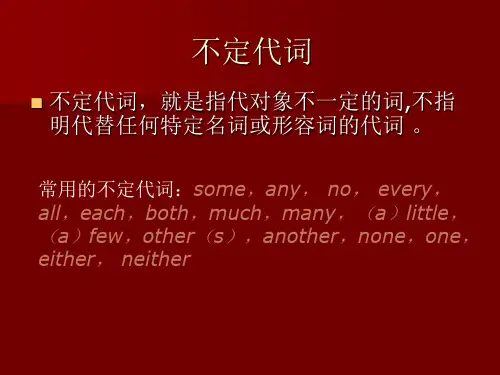
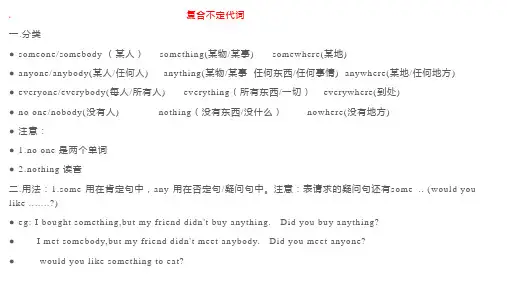
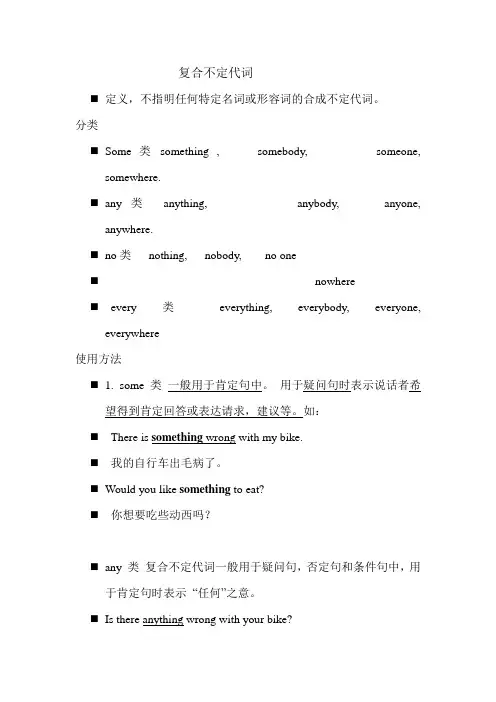
复合不定代词⏹定义,不指明任何特定名词或形容词的合成不定代词。
分类⏹Some类something , somebody, someone,somewhere.⏹any 类anything, anybody, anyone,anywhere.⏹no类nothing, nobody, no one⏹nowhere⏹every类everything, everybody, everyone,everywhere使用方法⏹1. some 类一般用于肯定句中。
用于疑问句时表示说话者希望得到肯定回答或表达请求,建议等。
如:⏹There is something wrong with my bike.⏹我的自行车出毛病了。
⏹Would you like something to eat?⏹你想要吃些动西吗?⏹any 类复合不定代词一般用于疑问句,否定句和条件句中,用于肯定句时表示“任何”之意。
⏹Is there anything wrong with your bike?⏹你的自行车出毛病了吗?⏹Is anybody here?⏹这儿有人吗?⏹Anyone of you can give me a hand.⏹你们谁帮我一下。
⏹3.复合不定词作主语时,都作单数看,其谓语动词用单数第三人称形式。
⏹something is wrong with my watch.⏹我的手表出毛病了。
⏹Everyone wants to win.⏹每个人都想赢。
⏹4.不定代词若有定语修饰(形容词,动词不定式to +动词原形),该定语要置于其后。
例如:⏹I have something important to tell you.⏹我有重要的事告诉你。
⏹Is there anything new in today’s newspaper.⏹今天的报纸上有新鲜事吗?⏹⏹你想吃点什么吗?。
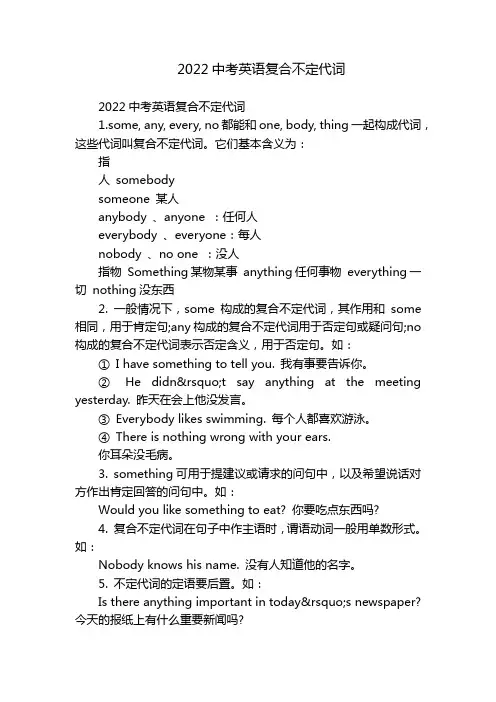
2022中考英语复合不定代词2022中考英语复合不定代词1.some, any, every, no都能和one, body, thing一起构成代词,这些代词叫复合不定代词。
它们基本含义为:指人somebodysomeone 某人anybody 、anyone :任何人everybody 、everyone:每人nobody 、no one :没人指物Something某物某事anything任何事物everything一切nothing没东西2. 一般情况下,some构成的复合不定代词,其作用和some 相同,用于肯定句;any构成的复合不定代词用于否定句或疑问句;no 构成的复合不定代词表示否定含义,用于否定句。
如:①I have something to tell you. 我有事要告诉你。
②He didn’t say anything at the meeting yesterday. 昨天在会上他没发言。
③Everybody likes swimming. 每个人都喜欢游泳。
④There is nothing wrong with your ears.你耳朵没毛病。
3. something可用于提建议或请求的问句中,以及希望说话对方作出肯定回答的问句中。
如:Would you like something to eat? 你要吃点东西吗?4. 复合不定代词在句子中作主语时,谓语动词一般用单数形式。
如:Nobody knows his name. 没有人知道他的名字。
5. 不定代词的定语要后置。
如:Is there anything important in today’s newspaper? 今天的报纸上有什么重要新闻吗?一般的,不定代词(包括复合不定代词)在句子中,通常用第三人称单数形式6。
复合不定代词的否定。
1、“not every-”表示的是部分否定,意为“并非都,不都”。
复合不定代词的用法及练习什么是复合不定代词?复合不定代词是由不定代词和介词、副词等组成的一个整体。
它们在句子中起到代词的作用,用来代替不确定的人或物。
常见的复合不定代词有以下几种:1. 不定代词 + of + 不定代词:其中之一、一些。
2. 不定代词 + of + 名词:之中的一部分。
3. 不定代词 + as + 不定代词:作为其中之一。
4. 不定代词 + as + 名词:作为其中的一部分。
复合不定代词的用法复合不定代词通常用来表示人或物的一部分或一个集体,具体用法如下:1. 复合不定代词 + of + 不定代词:- one of + 不定代词:其中之一。
- some of + 不定代词:一些。
- any of + 不定代词:任何一个。
- each of + 不定代词:每一个。
- both of + 不定代词:两者之一。
2. 复合不定代词 + of + 名词:- some of + 名词:其中的一部分。
- many of + 名词:其中的许多。
- most of + 名词:其中的大部分。
3. 复合不定代词 + as + 不定代词:- such as + 不定代词:例如其中之一。
4. 复合不定代词 + as + 名词:- same as + 名词:和其中的一部分一样。
复合不定代词的练请依次将下列句子中的空白处补充完成。
1. He is ___ the happiest person I know.2. ___ the children ate their breakfast.3. The museum has a collection of paintings, and ___ them were created by famous artists.4. In the library, ___ the books are arranged according to their genres.答案:1. one of2. Some of3. many of4. most of5. each of希望以上内容对你有所帮助!如果还有其他问题,请随时提问。
复合不定代词/不定副词语法一、复合不定代词/不定副词Someone anyone noone everyone Somebody any body nobody everybody某人某人/任何人没有人每人/人人 Something anything nothing everything某事/某物某事/某物没有任何事物一切/事事(以上三行为复合不定代词)Somewhere anywhere nowhere everywhere某地某地/任何地方没有地方处处(这一行是复合不定副词)Some oneAny bodyNo thingEvery where复合不定代词做主语时,谓语动词用单数形式1、例:Everyone knows me here2.形容词修饰不定代词时形容词在后 There is something new in today’s newspaper 3、Some以及Some构成的复合不定代词不定副词多用于肯定句,请求的疑问句、建议的疑问句、否定疑问句和疑问点不在Some上的疑问句①请求的疑问句:could you /I 动原/be…?4.any以及any构成的词在否定句中为完全否定Notany=nonot any one/anybody=none/nobody not… anything =nothing not…anywhere=nowhere5.any以及any构成的词也可用于肯定句Any:任何一个 any one=anybody 任何人 anything任何事物He is taller than anyone else in my class6.、no one=nobody/none7.no one回答who引导的问句,none回答how many 引导的问句①who is in the room? No one②How many people are there in the room? None8.复合不定代词后跟动词不定式,如;something to eat 练习题:1 “Haven't you forgotten ____ ?”“ ____ ,oh, I forgot my bag.”A.anything; Excuse me B.something; Excuse me C.something; Pardon D.everything; Pardon2.Be quiet! I have ____ to tell you.A.important anything B.anything importantC.important something D.something important3.Han Meimei, what about ____ to eat?A.everything B.something C.nothing D.anything ( ) 1. I’m hungry. I want ______ to eat.A. anythingB. somethingC. everythingD. not hing( ) 2. —Do you have ______ to say for yourself? —No, I have ______ to say.A. something; everythingB. nothing; somethingC. everything; anythingD. anything; nothing( ) 3. Why not ask ______ to help you?A. everyoneB. someoneC. anyoneD. none ( ) 4. Everything ______ ready. We can start now. A. are B. is C. be D. were( ) 5. There’s ______ with his eyes. He’s OK.A. anything wrongB. wrong somethingC. nothing wrongD. wrong nothing( ) 6. —The story is so amazing! It’s the most interestin g story I’ve ever read.—But I’m afraid it won’t be liked by ______.A. everybodyB. somebodyC. anybodyD. nobody( ) 7. She listened carefully, but heard ______.A. anyoneB. someoneC. everyoneD. nothing( ) 8. I agree with most of what you said, but I don’t agree with ______.A. everythingB. anythingC. somethingD. no thing( ) 9. —Everyone is here today, ______?—No, Han Mei isn’t here. She’s ill.A. isn’t itB. isn’t heC. are theyD. isn’t everyone( ) 10. Everything goes well, ______?A. is itB. isn’t itC. do theyD. doesn’t it。
复合不定代词复合不定代词是由some, any, no, every加-body, -thing, -one构成,列表如下:由于在使用中有比较特殊的习惯用法,是考试中比较常见的考点。
现将常见的考试形式解析如下:I.复合不定代词和部分否定部分否定是考试中的热门考点,常表达的结构有两种:1.not+全部肯定词2.助动词+not+全部肯定词其意都为“并非都,不都”。
前者是一般形态,如:Not everyone likes English. 由于是基本概念,学生比较容易理解。
但后者和一般否定比较相似,容易引起学生判断上的疑惑,是出题的焦点。
1.I agree with most of what you sai d, but I don’t agree with _____.A. everything B: anything C. something D. nothing分析:有同学看到I don’t agree就判断是否定句,选B, anything .这就是对句子理解出现了偏差。
句意是:我同意你所说的大部分,但不是全部。
是一句典型的部分否定形式。
not…everythi ng 的结构表明“并非每件事”。
所以正确答案是A. everything 。
2.----The exam was difficult, wasn’t it?----No, but I don’t think ______ could pass it.A. somebodyB. anybodyC. nobody D everybody分析:同上题一样,不能将I don’t think 简单得看成否定句而选B. anybody。
“not…everybody”构成部分否定,既“并非所有的人都能通过”。
所以应该选D. everybody。
II.复合不定代词的定语位置复合不定代词被定语修饰的时候,定语必须放在不定代词后面。
特别是当修饰的定语比较复杂的情况下要认真分析,弄清词序间的修饰关系。